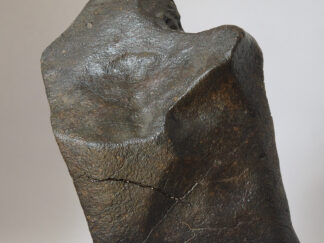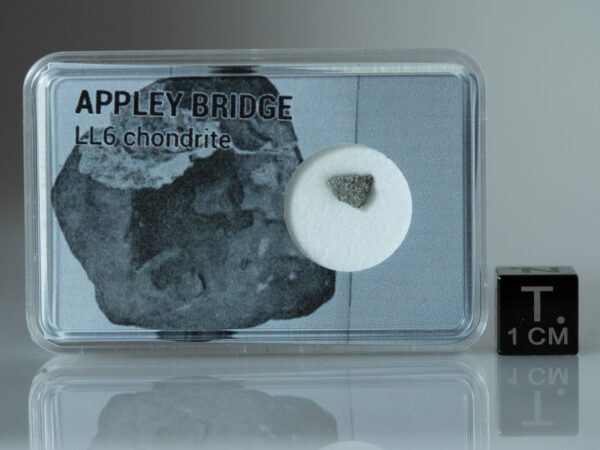Description
On offer: a fragment of this nice fall from Norway.
Dimensions: ~2 x 2 mm
What you get: this fragment, a plastic box with label at the back, a signed Certificate of Authenticity.
Type: H3-6 chondrite
Country: Norway
Date of fall: March 9, 2012
Total mass: 4.35 kg
Oslo 59°55’47.66’’N, 10°46’17.96’’E
Oslo, Norway
Probable fall: 2012 Mar 9
Classification: Ordinary chondrite (H3-6)
History: The first piece of the meteorite was found by Anne-Margrethe Thomassen in her cabin house at Rodeløkka, Oslo, on March 12, 2012. The meteorite had hit the edge of the roof and split into two pieces, 550 g in total mass. The hole in the roof was not there a few days before, so the estimated fall date is March 9 or 10. Two independent sources also claim they heard a loud sound on the afternoon of March 9. No fireball that can be connected to the fall was reported by the Norwegian Meteorite network, but it was very cloudy in Oslo around those days. Some days later, a 700 g piece and a 26 g specimen were both found on Ekebergsletta, Oslo, located ~4 km away from Rodeløkka. In this location, near the Ekeberg kindergarten, a full piece 115 g in mass was found soon after. Many further pieces were also recovered during systematic, organized meteorite search; they total 150 g, but individual stones do not exceed 30 g. A further, but unofficial find of 4.65 kg at Grefsen, was reported in the media, but this putative meteorite has not been available for scientific investigations for verification (Bilet & Selbekk 2013). On 6 February 2014, i.e. two years later, another piece (2.8 kg) was found by Steinar Engh at Kjelsås, Stilla. The piece was stuck in the roof and was recovered during maintenance work.
Physical characteristics: The type specimen in the collection of Natural History Museum in Oslo broke apart into two, separate roughly equal-sized stones. The specimen has clearly developed secondary fusion crust, indicating that fragmentation of larger body occurred in the atmosphere before fall. The specimen is fresh, not weathered and the interior seen on broken surfaces reveals brecciated light-dark structure with light clasts up to several cm in size embedded in dark matrix.
Petrography: (A. Krzesinska, UOslo) The meteorite has brecciated light-dark structure with a major light-colored lithology and dark parts containing many cm-sized clasts of various appearances. The light part is classified as H6, with plagioclase grains up to 60 μm in size. The dark material contains aboundant chondrules and clasts of unequilibrated material set in cataclastic olivine-pyroxene matrix. In both lithologies, olivine crystals are fractured and reveal planar fractures and undulose extinction. No melt pockets or veins are present. Native copper locally occurs within plessite grains.
Geochemistry: (A. Krzesinska and M. Erabmert, UOslo) Light part of the breccia is composed of olivine with Fa19.3 (Fa18.8-19.6, n=37), orthopyroxene Fs16.6Wo1.6 (Fs16.6-17.3Wo1.0-1.9, n=24), plagioclase An13.3Or5.6 (n=9, range An12.8-14.0Or4.8-7.1) and kamacite (0.44-0.56 wt% Co), taenite and tetrataenite present. Accessory minerals include troilite, chromite (78.6 mol% Chr, 14.2 mol% Sp), ilmenite, diospide, Cl-apatite and merrillite. Chondrules in the dark lithology are composed of zoned olivine (Fa0.9-24.7, n=19) and pyroxene (Fs2.5-16.5Wo0.2-0.9, n=14) crystals. The composition of matrix in the dark lithology is more equilibrated than the chondrules and it reveals olivine with Fa18.9±0.51, and opx Fs16.9±0.23Wo1.4±0.3.
Classification: Brecciated, ordinary chondrite of H3-6 type, based on composition of olivine, pyroxene as well as content and composition of kamacite. Light part is highly equilibrated H6 material and dark part is of H3 type, however, individual cm-sized clasts in the dark part can be classified as H4 or H5 type material.
Specimens: (H. Friis, M. Bilet, R. Selbekk, UOslo) Several specimens were recovered over the time. The first specimen (type specimen and main mass), weighting 550 g is in the collection of Natural History Museum in Oslo. Three thin sections are stored in the museum. Some more specimens of various sizes (totaling 4 kg) are in private collections, and based on unofficial reports, an additional 4.6 kg may exist.






